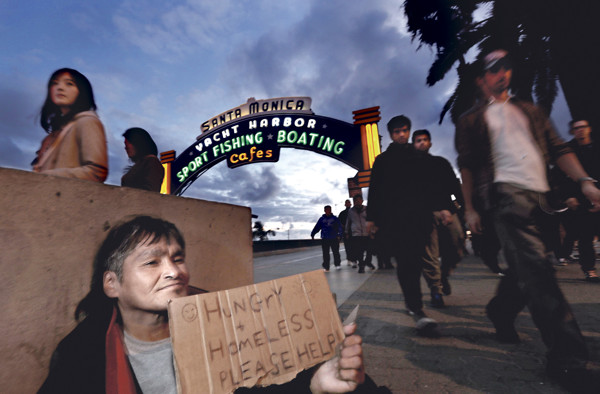Santa Monica’s Homelessness Strategy is Showing Results
June 17, 2019 9:05 AM
by Rick Cole

L.A. Mayor Eric Garcetti called the news “heartbreaking.” LA County Supervisor Mark Ridley-Thomas admitted he was “stunned.” The Los Angeles Times distilled the grim results of the 2019 Homeless Counts for the City and the County of Los Angeles:
"In a hard reality check for Los Angeles County's multi-billion-dollar hope of ending homelessness, officials reported Tuesday that the number of people living on the streets, in vehicles, and in shelters increased by about 12% over last year. The annual point-in-time count, delivered to the Board of Supervisors, put the number of homeless people just shy of 59,000 countywide. Within the city of Los Angeles, the number soared to more than 36,000, a 16% increase."
The numbers sparked an immediate and intense round of finger-pointing. In a column splashed across the front page, Times writer Steve Lopez blamed “city and county officials.” According to Lopez, they “move too slowly and preside over an evolving catastrophe that may get worse before it gets better, even with thousands more housing units in the pipeline.” The fast-flying accusations followed predictable patterns, focused on blame and point-scoring rather than fresh insights.
Across California, the homeless count numbers are even more dire than LA County. Orange County recorded a 43% increase from its last count in 2017 and Ventura, San Bernardino and Kern counties all reported increases of more than 20%. Up north, Alameda County saw a 43% increase and Santa Clara County was up 31% since their last counts in 2017. San Francisco recorded a 17% jump.
It’s a different story in Santa Monica. We announced the results of our 2019 Homeless Count back in March. Even taking into account the limitations of the methodology for counting people experiencing homelessness, our local results were encouraging. The 3% increase was well within the range of statistical variance – which means our numbers were essentially flat. Most striking, the number counted in our Downtown showed a 19% decrease. Why is that significant? Because that’s where we’d focused our intense outreach and engagement strategies. The results seem to vindicate that we are on the right track.
So what’s working in Santa Monica? During the past three decades, we’ve built a solid foundation. Homelessness is not a new problem for us. As Alisa Orduna, our Senior Advisor on Homelessness notes: “Our first spike in homelessness was in the late 1980s into the 1990s. We had another surge following the economic recession of 2008, and we are now in the midst of one that began in 2016. We do see people living with mental illnesses, but beyond that, we’re seeing the impact of the housing crisis.” Orduna, who coordinates Santa Monica’s efforts to combat homelessness, explains that we previously focused on those “who grew up here, went to school here, had their last permanent address here, and so on.”
When the regional surge in homelessness since 2016 overwhelmed that approach, Santa Monica pivoted to a relentless focus on outreach and engagement. That approach is getting traction – and showing results.
Our Police Department has long had a model Homeless Liaison Program (HLP Team). Former Interim Chief Ken Semko and new Chief Cynthia Reynaud not only expanded the team’s size, but they also deployed our Patrol and our Public Safety Officers to focus on our public spaces. After City Council adopted “a regional approach to homelessness” as one of their Strategic Priorities, we created a pilot Homeless Multi-Disciplinary Street Team (HMST). It’s a new model for successful street medicine aimed at our most chronic users of emergency services. A new Rand Report credits the team with measurable success in changing lives.

Senior Advisor on Homelessness Alisa Orduña
Orduna describes the safety net that Santa Monica has created: “We have about 400 emergency shelter beds, which serve the entire region. We were one of the first cities to embrace the Housing First model and build permanent supportive housing (PSH); we now have about 330 PSH units. We also have an access center where people can shower, pick up their mail, and see a medical doctor or nurse practitioner, as well as link to case management services.”
We adopted and funded a C3 Team to fan out across Downtown to connect people with services. Our Library launched a wide range of effective measures, with new staffing, including two part-time social workers. Fire launched a Community Response Team pilot. A Community Steering Committee enlisted additional civic, social, business and religious resources to work collaboratively.
Engagement only goes so far. The housing affordability crisis continues to worsen regionally and the region is far behind in building enough permanent supportive housing to address the magnitude of the problem. But Santa Monica’s success with outreach and engagement is a necessary link to longer-term solutions -- and it’s working.
We’re determined to do more. We’ve developed a revised Action Plan to Reduce Homelessness. It’s a blueprint for continuing and expanding our efforts. We are quickening the pace of experimenting with new tactics to pursue four key goals:
- Prevent housed Santa Monicans from becoming homeless and increase affordable housing opportunities
- Address the behavioral health needs of vulnerable residents
- Maintain equitable access to safe, fun, and healthy open spaces
- Strengthen regional capacity to address homelessness
To learn more about this critical challenge, follow the links I’ve included here and to find ways you can help, check out We are Santa Monica.
Authored By
Rick Cole
City Manager